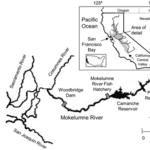Ecology & Zoology

I'm stoked to be joining the blogging team at KQED QUEST--a Northern California science multimedia extravaganza! My first post went up yesterday. As you can see, it required extremely rigorous and extensive consumption of chocolate.I'll be writing a piece for them every Tuesday, which should leave me free to continue posting squid news here on my current irregular-but-still-reasonably-frequent schedule. Today, though, you'll have to head over to Squids4Kids for your fix. I posted two new articles there: Predators, Prey, and Parasites and Sex and Babies. Enjoy!

Probably not. No one's ever heard a squid make any kind of noise, really, other than "splash" at the sea surface.But if you read io9's fantastic piece on the deep sea's mysterious sounds, you'll learn about The Bloop, an unexplained deep-sea noise from 1997. What could have made it?
[One] possibility is some sort of massive squid. These creatures do serve as a catch-all for all that's still mysterious about the ocean depths, and our extremely limited firsthand knowledge of them makes it easier to believe a gigantic Blooping squid could maybe be hiding deep in the Pacific. There's a couple…

Gary Griggs, director of the Institute of Marine Sciences and Long Marine Laboratory at UC Santa Cruz, wrote a nice piece for the Santa Cruz Sentinel on the history and current status of California's commercial fisheries. Squid, of course, play a starring role:
In 2010, California's biggest catch by far was market squid, coming in at over 144,000 tons, or 66 percent of the state's entire commercial catch. This is eight pounds of squid for every person in California. . . . Squid are attracted to the surface at night using very bright lights, where they are caught in nets. They only live…

The Freeport News--"Grand Bahama's First Newspaper"--ran an article today that was a mix of highly detailed biology and complete bone-headed confusion.
Could there be a healthy squid population living in local waters? has a fantastic opening:
Is it a possibility that there is a healthy squid population in waters around Grand Bahama?Although, at this point, there is no official answer to the question from the proper authority, this daily will continue to search and keep our readers updated.
Mystery! Intrigue! The authorities may be ignoring the situation, but never fear, the journalists will…

While anti-science politicians in Washington, D.C. block science solutions to harvesting more fish, a crucial piece of information about salmon isn't being considered; the numbers without a science solution only look good because of the massive influx of hatchery-raised fish that return to spawn in the wild. Only about ten percent of the fall-run Chinook salmon spawning in California's Mokelumne River are naturally produced wild salmon.
The Mokelumne River is one of the major salmon producing rivers for fall-run Chinook salmon in California. Throughout the Central Valley rivers,…

Peru is at the cutting edge, the forefront--nay, Peru is a veritable trendsetter, trailblazer, and spearheader--because Peru, alone in the world, has decided to set a quota for Humboldt squid.
Before you go off in a huff about how ridiculous I'm being*, let me explain why this is kind of a big deal. First, the Humboldt squid fishery is the biggest squid--the biggest invertebrate--fishery in the world. Second, no single country (or group of countries, for that matter) has ever set a quota for Humboldt squid before. That means fishermen have, by and large, been free to catch as many…

Peru is at the cutting edge, the forefront--nay, Peru is a veritable trendsetter, trailblazer, and spearheader--because Peru, alone in the world, has decided to set a quota for Humboldt squid.
Before you go off in a huff about how ridiculous I'm being*, let me explain why this is kind of a big deal. First, the Humboldt squid fishery is the biggest squid--the biggest invertebrate--fishery in the world. Second, no single country (or group of countries, for that matter) has ever set a quota for Humboldt squid before. That means fishermen have, by and large, been free to catch as many…

I spend quite a lot of time here at Squid A Day blathering about one fishery or another, and I ought to remember that the word "fishery" isn't exactly common parlance. It's not jargon in the same way as "chromatophore" or, Lord help us, "mesopelagic." Still, it doesn't have an intuitive meaning to a lot of folks.
So when I wrote a short essay for the Squids4Kids program about squid fisheries, I opened with a discussion of just what a fishery is, before going on to talk about squid.
Have you ever gone fishing? Depending on where you live, you may have gone fly fishing for trout, ocean fishing…

Most of the time, fishermen fish for one particular creature--be it tuna, sardines, or shrimp. Unfortunately, species tend to exist in a commingled muddle called ecology, and it's often difficult to separate them with fishing gear.
On the east coast of the US, longfin squid are caught with trawl nets. When dragged through the water, trawl nets also collects things which are not squid, called bycatch. And although the population of longfin squid seems to be reasonably healthy, some of these bycatch species are not doing so well.
River herring is one of these unfortunates. Back…
It seems that certain great ideas have Times. Like, whoever's alive at that time, it doesn't matter--they're going to discover electricity, because the idea's in the ether. Or whatever.
So as it turns out, 2009 was the Time of finding neurotoxins in stranded Humboldt squid. I mean, obviously, right? Or, um, maybe not.
Let me explain: in 2009, a bunch of Humboldt squid stranded on beaches up and down the Pacific coast of North America. And two entirely independent groups of people had the same brilliant idea of taking samples from these stranded squid and looking for neurotoxins.
Why…